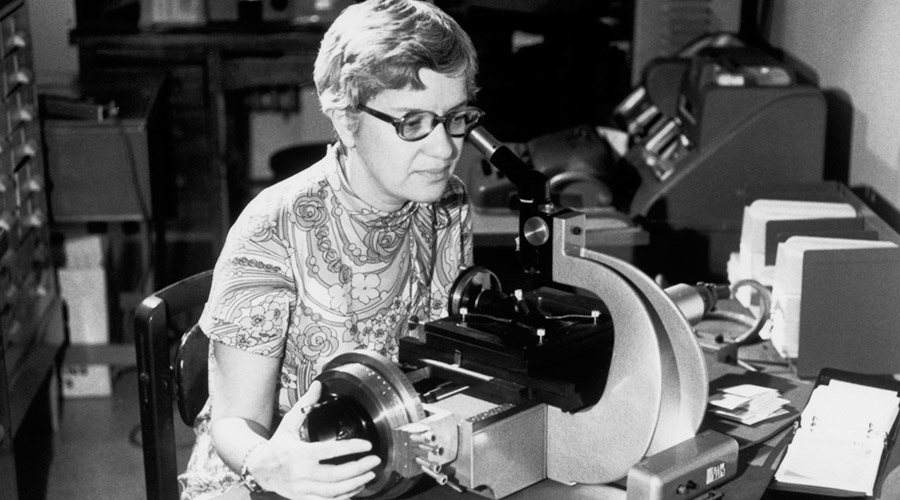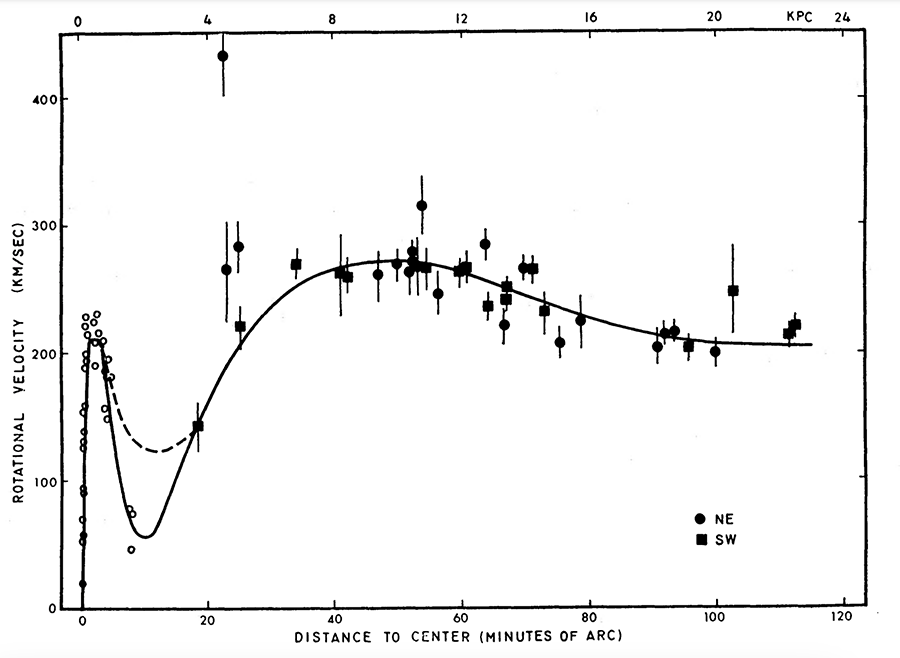June 1980: Vera Rubin Publishes Paper Hinting at Dark Matter
Work by Rubin, a champion of women in science, suggested that galaxies contain hidden mass.
By Tess Joosse | May 11, 2023

Credit: AIP Emilio Segrè Visual Archives, Rubin Collection
Vera Rubin measuring spectra at the Carnegie Institution of Washington in 1970.
In 1933, the Swiss astronomer Fritz Zwicky was perplexed by the behavior of the Coma cluster of galaxies, some one thousand-strong. The cluster spun so fast that it ought to burst apart — but didn’t. Zwicky postulated it was hundreds of times more dense than it seemed to be based on visible, glowing matter alone, meaning some kind of invisible “dunkle Materie,” or dark matter, must bind it together.
The concept did not catch on. “It was too outrageous to believe for almost four decades,” says Neta Bahcall, an astrophysicist at Princeton University. But by 1980, an astronomer named Vera Rubin had accumulated a convincing body of evidence that something unseen in the universe was causing galaxies to behave in unexpected ways.
Rubin, born Vera Cooper in 1928, was raised in a Jewish family in Philadelphia and Washington, DC. She was captivated by the cosmos and relentlessly curious from the start. In an autobiographical article published in the 2011 Annual Review of Astronomy and Astrophysics, Rubin recalled her father helping her build a homespun telescope using a linoleum tube. “From my bed against a window, I had a clear view to the north sky,” she wrote. “Soon it was more interesting to watch the stars than to sleep.”
Throughout her schooling, Rubin faced the banal sexism all too common at the time for women interested in science. Her high school physics teacher ignored the few girls in class; a college admissions interviewer encouraged her to consider painting astronomical objects rather than studying them. Rubin was not deterred. “She took it all with courage, and with persistence,” says Bahcall, who was a longtime friend and colleague of Rubin.
Rubin studied astronomy at Vassar College, married mathematical physicist Bob Rubin, and began graduate school at Cornell in 1948. She completed her master’s thesis on the rotation of the universe, kicking off a long career investigating hidden galactic behavior, and a professor suggested Rubin present this research at a meeting of the American Astronomical Society (AAS) in 1950. There, she encountered a chilly reception. “I gave my memorized 10-minute talk, acceptably I thought. Then one by one many angry sounding men got up to tell me why I could not do ‘that,’” she wrote.
In 1965, after obtaining her PhD and teaching and traveling with her family for several years, Rubin got a job in the Department of Terrestrial Magnetism at the Carnegie Institution of Washington. She met W. Kent Ford Jr., who was building a new spectrograph for collecting light data from far-away bodies. “Potentially, this pioneering technique could increase by tenfold or more a telescope’s ability to record the spectrum of a faint object,” write Jacqueline Mitton and Simon Mitton in the 2021 biography Vera Rubin: A Life.
Rubin and Ford put the instrument to work measuring the velocities of stars in M31, the Andromeda galaxy. As planets in our solar system grow more distant from the Sun, their orbital velocities decrease. The stars in M31 were expected to do the same the further they were from their galaxy’s center, where the light was brightest and the mass was expected to be the greatest. These speeds could be calculated based on spectroscopic data and plotted graphically on a sloping rotation curve.
But the curve Rubin plotted for M31 trailed off in a nearly flat line: the orbital velocities of stars far from the galaxy’s center did not decrease. It was as if the galaxies contained unseen mass, allowing them to rotate at the observed speeds without spinning out of control. “I remember thinking that there must be some mechanism for speeding up stars that moved too slowly or slowing down stars that moved too fast,” Rubin recalled.

Credit: V. Rubin and K. Ford, Astrophysical Journal, vol. 159, p.379 (February 1970).
Rotational velocities of the stars in the Andromeda galaxy, from a 1970 paper by Vera Rubin and Kent Ford. Instead of a downward slope, which would show that stars further from the star had slower velocities, the curve is nearly level — evidence for the pull of unseen mass, or dark matter.
Between 1976 and 1986, Rubin and Ford undertook an ambitious observational survey of many other spiral galaxies. “She was very persistent in accumulating more and more data,” Bahcall says. The team published nearly 50 papers during this time. In their most influential, which appeared in the June 1980 issue of the Astrophysical Journal, Rubin charted the rotation curves of 21 spiral galaxies spanning a range of sizes and luminosities. All of them had flat rotation curves extending far from their centers. In the paper, Rubin wrote, “The conclusion is inescapable that non-luminous matter exists beyond the optical galaxy.”
These observations, paired with work by theorists and radio astronomers, showed that if the rules of Newtonian physics were to hold true, there must be a large amount of unseen mass in these galaxies. Today, the widely accepted thesis is that galaxies are full of dark matter, and up to 85% of the mass in the universe is made of it.
What dark matter actually is, however, remains a mystery. Experimental physicists the world over search for it, and scientists have spent countless hours debating its identity. While Rubin’s work helped ask this question, Bahcall says that she remained “agnostic” about its answer. “Scientists too seldom stress the enormity of our ignorance,” Rubin wrote in the preface to Bright Galaxies, Dark Matters, her collection of papers published in 1997.
Throughout her decades-long career, Rubin continued to chart galactic phenomena. She also was a mentor to and champion of young astronomers, especially women who still faced obstacles in the male-dominated field. Rubin often contacted the organizers of conferences to admonish them if their speaker lineup did not include enough women, Bahcall says. Along the way, she and her husband Bob raised four children, who all became scientists. When Rubin died in 2016, she was remembered as a transformer of modern physics and a beacon of light to many. “She was a very kind, compassionate, curious human being,” Bahcall says.
In 2019, almost 70 years after Rubin faced that hostile crowd at the 1950 AAS meeting, the Society convened in Honolulu to agree on renaming the Large Synoptic Survey Telescope as the Vera C. Rubin Observatory. After its construction is complete, the Rubin Observatory will be the site of a 10-year survey of a mammoth swath of night sky. Bahcall sees this honor as the perfect tribute to Rubin, who cherished the many long nights she spent in observatories, peering through telescopes. “She loved being in the dome.”
Tess Joosse is a science journalist based in Madison, Wisconsin.
©1995 - 2024, AMERICAN PHYSICAL SOCIETY
APS encourages the redistribution of the materials included in this newspaper provided that attribution to the source is noted and the materials are not truncated or changed.
Editor: Taryn MacKinney
June 2023 (Volume 32, Number 6)
Articles in this Issue

